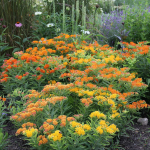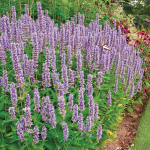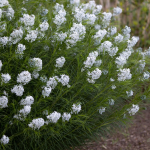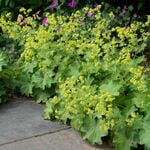Product Details
Flaring dark purple outer petals and spurs dramatize the white-rimmed inner petals of this striking bicolored Columbine. The depth of color, almost black, inspires fascinating design combinations with brighter blossoms and silver or chartreuse foliage. Deadhead to encourage repeat bloom, and refresh the ferny foliage with a midsummer haircut.
Lacy greens and dancing, late-spring blooms characterize these lovely border plants. Columbines make excellent cut flowers if picked when half open. Grow in full sun or partial shade (required in the South and in western Zones 9 and 10) and average garden soil. Propagation is by seed, so color, while quite reliable, cannot be guaranteed.
For more information on the growing and care of Aquilegia, click Growing Guide.
Shipping
HOW PLANTS ARE SHIPPED
The size of the plants we ship has been selected to reduce the shock of transplanting. For some, this means a large, bareroot crown. Others cannot travel bareroot or transplant best if grown in containers. We ship these perennials and annuals in 1 pint pots, except as noted. We must point out that many perennials will not bloom the first year after planting, but will the following year, amply rewarding your patience. We ship bulbs as dormant, bare bulbs, sometimes with some wood shavings or moss. Shrubs, Roses, vines, and other woody plants may be shipped bareroot or in pots. The size of the pot is noted in the quick facts for each item.
WHEN WE SHIP
We ship our bulbs and plants at the right time for planting in your area, except as noted, with orders dispatched on a first-come, first-served basis by climate zone. We also ship a wide range of containers and planters, tools, supplies, fertilizers, garden wear, garden decor items, as well as indoor decorations like wreaths and dried bouquets when available. Estimated dates for shipping are indicated in the green Shipping Details box for each item. Please supply a street address for delivery. Kindly contact us with two weeks notice, if you'll be away at the expected time of delivery.
OUR GUARANTEE
We guarantee to ship plants that are in prime condition for growing. If your order is damaged or fails to meet your expectations, we will cheerfully replace or refund it. Please contact our Customer Service Department at 1-800-503-9624 or email us at [email protected]. Please include your order number or customer number when contacting us.
Reviews
Average Customer Rating:
 (2 Reviews)
Write a Review
(2 Reviews)
Write a Review
Sort by:
This is a stunner 
psp from telluride, co
beautiful plant 
riv from pine grove ca
Growing guide
Latin Name Pronunciation: ak-wee-lee'jee-uh
Columbines are very floriferous, compact perennials whose graceful flowers are beloved of hummingbirds. Hardy in zones 3 to 9, Columbines bloom in early to mid-spring in solid colors and bicolors, including pink, red, blue, purple, yellow, and white. Foliage ranges from bright green to blue green and is quite attractive in the border when the plants are not in bloom. Columbines are particularly long lasting as cut flowers, and are admired for their delicacy and lovely range of soft colors. Although somewhat short-lived, these plants often self-sow.
Light/Watering: Drought-tolerant once established, these plants are at their best in evenly moist soil in partial shade, although they do well in full sun with sufficient water.
Fertilizer/Soil and pH: Columbines can thrive in average, well-drained soil that is slightly acid to neutral and will benefit from a light application of fertilizer in early spring.
Pests/Diseases: Columbine leaf miners leave tell-tale white serpentine trails on the foliage. Handpick affected leaves at the first sign of damage and dispose of away from the garden area. These pests overwinter in the soil, so cultivating around the plants in early spring while they are dormant may help with control. Another common pest is the Columbine sawfly, capable of completely defoliating plants quite quickly. Look for these small green, caterpillar-like larvae as soon as the leaves fully emerge and handpick or treat with soap spray. Unsightly foliage may be cut back entirely after the plant blooms, resulting in fresh, new leaves.
Companions: Columbines are lovely with other denizens of light shade such as Ferns, Tiarella, Campanula, Alchemilla, Phlox divaricata, and Pulmonaria, and truly enliven woodland gardens. The dwarf varieties are ideal for trough and rock gardens while the larger, more exuberant cultivars are a great addition to the herbaceous border.
Reflowering: If the gardener is devout with deadheading, new buds will develop along the stems and the bloom season can extend to as long as six weeks. Some varieties may be short-lived, but most self-sow with abandon if some flowers are left on the plant to maturity.
Dividing/Transplanting: Columbines transplant easily when taken up with a generous amount of soil and then watered well. Old clumps of Aquilegia may be divided but the results are often disappointing; new plants can be grown from seed but will take a year or two to bloom and will not come true to type when seed is harvested from open-pollinated plants. Purchasing mature plants will guarantee earlier blooms of the variety or species desired.
End-of-Season Care: Foliage should be cut back in the fall and removed from the premises to discourage overwintering of pests. In some soils, plants may be heaved out of the ground during freeze-thaw cycles in winter; mulch with salt marsh hay or evergreen boughs in late fall to prevent this.
Calendar of Care - Aquilegia
Early Spring: Apply a light application of balanced or slow-release fertilizer or side-dress with compost and organic amendments when new growth appears. Supplement nitrogen during periods of prolonged rain to counter natural leaching. Water well if it is unseasonably dry, as plants prefer evenly moist soil.
Late Spring: Watch for leaf miner activity and handpick affected leaves. If infestation is severe, simply cut the foliage down to the ground after flowering; new growth is quick to reappear with regular watering. Remove foliage from garden (do not compost). Inspect the undersides of leaves for small green, caterpillar-like larvae of the Columbine sawfly. Handpick or spray with insecticidal soap. Watch for aphid infestations; spray with insecticidal soap. Mulch plants as soil warms to buffer soil moisture and temperature. Plants can be carefully divided but this is not required.
Summer: Pull out any unwanted new seedlings as hybrid cultivars may not come true from seed; move desirable species seedlings to permanent locations. Pinch off dead flowers to encourage longer bloom period and prevent self-sowing. Groom plants by removing yellow or dead leaves.
Fall: Cut foliage back to soil level. After the ground is frozen, mulch to protect plants from heaving out of the soil in winter.








